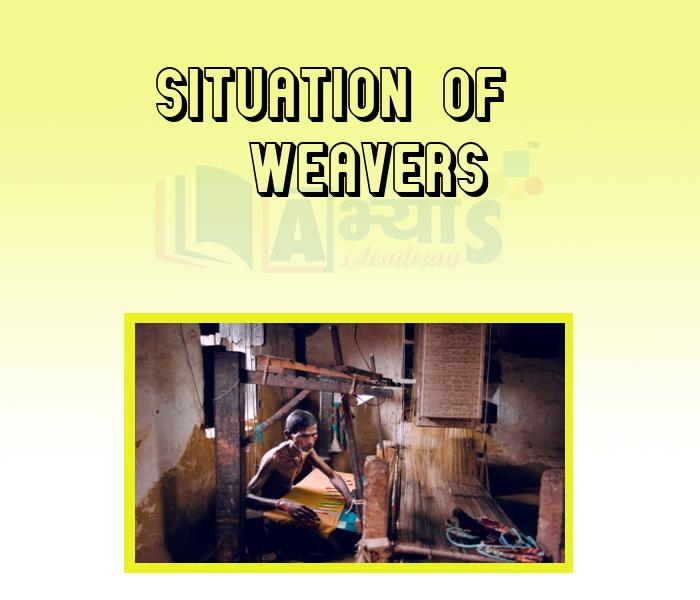Situation of Weavers













Situation of Weavers
Situation of Weavers: As Indian fine textiles were in great demand in Europe, the East India Company was keen on expanding textile exports from India. Before establishing political power in Bengal and Carnatic in 1760s and 1770s, the East India Company found it difficult to ensure a regular supply of goods for export. The French, Dutch, Portuguese and local traders competed in the market, thus the producer had a bargain power. The officials of the East India Company faced problems for getting smooth supply and they also complained about the high prices of the product. Once, the Company established its political power, it started to eliminate its competitors and tried to assert a monopoly right to trade.
They did it through the following steps:-
Step I Elimination of existing traders and brokers The Company tried to eliminate the existing traders and brokers connected with the cloth trade and establish a more direct control over the weaver.
Step II Prevention of Company weavers from dealing with the buyers Company prevented its workers from dealing with buyers. To do so, system of advances was followed. Once the order was placed, the weavers were given loans to purchase the raw material for their production.
In many places of Bengal and Carnatic, weavers left villages and migrated to different villages. Sometimes, they even revolted against the Company and refused to take loans. Those, who took loans had to hand over their product to the gomasthas. They lost any chance of bargaining. Many weavers had to lease out their land and devote all their time to weaving.
Gomasthas: The East India Company started appointing gomasthas i.e. paid servant to supervise weavers, collect supplies and examine the quality of the cloth. In fact, weaving required the labour of entire family i.e. children and women all engaged in this process. The new gomasthas, having no social links with the villages, acted arrogantly and punished the weavers for delay in supplies. They marched into villages with sepoys and peons and often punished the weavers by beating with stick. Further the weavers received low prices from the Company.
Contrary to this, earlier supply merchants lived within the same weaving villages and maintained a close relationship with the weavers. They looked after the needs of weavers and even helped them in their times of crisis.
#Sepoy :- This is how the british pronounced the word sipahi, meaning an indian soldier in the service of the british .
Students / Parents Reviews [10]
It was a good experience with Abhyas Academy. I even faced problems in starting but slowly and steadily overcomed. Especially reasoning classes helped me a lot.

Cheshta
10thBeing a parent, I saw my daughter improvement in her studies by seeing a good result in all day to day compititive exam TMO, NSO, IEO etc and as well as studies. I have got a fruitful result from my daughter.

Prisha Gupta
8thAbhyas is a complete education Institute. Here extreme care is taken by teacher with the help of regular exam. Extra classes also conducted by the institute, if the student is weak.

Om Umang
10thIt has a great methodology. Students here can get analysis to their test quickly.We can learn easily through PPTs and the testing methods are good. We know that where we have to practice

Barkha Arora
10thI have spent a wonderful time in Abhyas academy. It has made my reasoning more apt, English more stronger and Maths an interesting subject for me. It has given me a habbit of self studying

Yatharthi Sharma
10thAbout Abhyas metholodology the teachers are very nice and hardworking toward students.The Centre Head Mrs Anu Sethi is also a brilliant teacher.Abhyas has taught me how to overcome problems and has always taken my doubts and suppoeted me.

Shreya Shrivastava
8thA marvelous experience with Abhyas. I am glad to share that my ward has achieved more than enough at the Ambala ABHYAS centre. Years have passed on and more and more he has gained. May the centre flourish and develop day by day by the grace of God.

Archit Segal
7thIt was good as the experience because as we had come here we had been improved in a such envirnment created here.Extra is taught which is beneficial for future.

Eshan Arora
8thOne of the best institutes to develope a child interest in studies.Provides SST and English knowledge also unlike other institutes. Teachers are co operative and friendly online tests andPPT develope practical knowledge also.

Aman Kumar Shrivastava
10thAbhyas Methodology is very good. It is based on according to student and each child manages accordingly to its properly. Methodology has improved the abilities of students to shine them in future.
